Norvic Philatelics - GB New Stamps and Special Postmarks
Piers Proms and Pavilions: Seaside Architecture - 18 September 2014
The
seaside town evolved as a place where the visitor could find a
fantasy environment and enjoy entertainments that could not be
found elsewhere.
The
Seaside
Architecture stamps and miniature sheet are issued on the
occasion of the 500th anniversary of the founding of Trinity
House, the body responsible for all UK lighthouses and
lightships. (wikipedia,
official site)
The
first pier in the UK was completed at Ryde
on the Isle of Wight on 26 July 1814, so celebrating it's
200th anniversary this year.
The Eastbourne Bandstand 1st class stamp, with its brass band,
includes the EUROPA
logo, which is Royal Mail's nod to the Post-Europ
2014 theme of 'National musical instruments'.
|
|
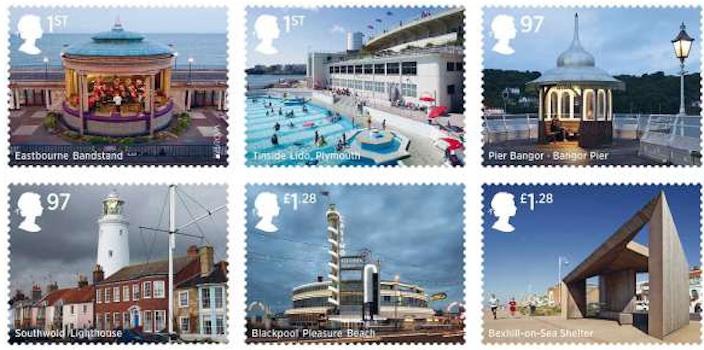 1st class - Eastbourne
Bandstand - Tinside Lido, Plymouth
1st class - Eastbourne
Bandstand - Tinside Lido, Plymouth
97p - Bangor Pier - Southwold Lighthouse
£1.28 - Casino, Blackpool Pleasure Beach - Bexhill-on-Sea
Shelter
|
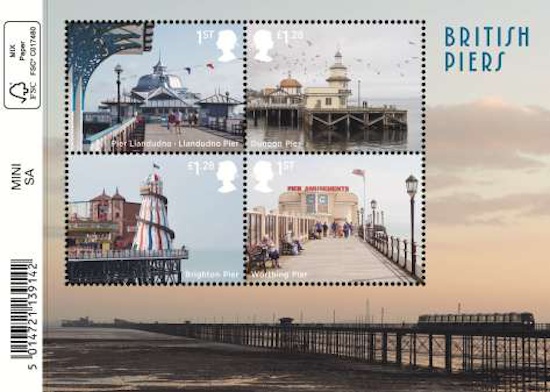
British Piers: 1st class:
Llandudno, £1.28 Dunoon
£1.28 Brighton Palace Pier, 1st class Worthing |
Background
The seaside holiday is a British
invention. Scarborough has the honour of being the world’s first seaside
resort and is also the location of the first recorded use of the ‘bathing
machine’ (1735). It was in the 18th century that visits to the seaside for
the health effects of the sea air became fashionable with the wealthy.
Getting to the coast though could pose a problem with the choice of
expensive stage coaches or slow sailing vessels.
The first piers arose as a solution to reaching these seaside watering
places. The first (Ryde Pier, on the Isle of Wight, 1814) was simply a
platform to make getting on and off boats easier. With the growth in
reliable steam-driven vessels and regular services to places like Margate
and Weymouth, piers became the alternative to wading through water or being
carried ashore from the boats.
This stamp issue captures the spirit of the seaside experience through the
buildings and structures that are exclusive to, or very distinctive of, the
UK’s resorts, which were designed for the pleasure of the visitor. The
structures represent the key time periods of seaside development including:
Victorian, Art Deco, Modernism of 1930s and up to present day, showing that
contemporary architecture/design is being used to regenerate these
resorts.
The chosen selection captures distinctive types of seaside architecture from
key periods when major investment led to innovation, in particular the late
Victorian era and interwar years. There is a good range of resort type -
large and small, well-known and less so - from the number one working-class
resort of Blackpool to the more sedate Southwold which has grown in
popularity as a result of its quiet nostalgic feel. All of the chosen
structures are fine examples of their type and the fact that they have been
newly photographed as vibrant, well-used places helps celebrate the
resurgence of interest in the British seaside which has happened over the
last two decades. The contemporary shelter at Bexhill (much criticised
locally) brings the story right up to date.
The stamps in detail
Eastbourne Bandstand – a unique
mid-1930s semi-circular design from the Art Deco period but also with a hint
of the Orientalism that had been a distinctive feature of seaside
architecture since construction the of the Brighton Pavilion. In the days
before recorded music and radio, bandstands were to be found at all resorts.
Tinside Lido, Plymouth – One of the
best surviving lidos in the country and recently renovated. Built in a
Modernist style that really captures the latest fashions of the interwar
period, especially outdoor recreation and sunbathing.
Bangor Pier - Piers represent the great engineering feats
achieved in seaside architecture but the Victorians also exploited cast iron
in smaller structures that have come to define the seaside atmosphere. The
kiosk on Bangor Pier is a great Victorian example on a Welsh pier.
Southwold Lighthouse – Tying in with the Trinity House
500th anniversary in 2014, the lighthouse in the middle of Southwold is one
of the symbols of a town that represents a resurgence of seaside popularity
based on traditional ‘bucket-and-spade’ activities, but where the purchase
price of a beach-hut on the prom could set you back £100,000.
Casino, Blackpool Pleasure Beach – a nationally important
example of Modernist architecture and one in which architect Joseph Emberton
captured the playfulness of the seaside environment. From its start in the
1890s the Pleasure Beach came into its own during the interwar years and
this structure is arguably the culmination of its 1930s revamp.
Bexhill-on-Sea Shelter – innovative contemporary
architecture has been a major driver of regeneration at the seaside and even
seemingly ephemeral structures like shelters can make a big impact on the
overall feel of an otherwise traditional promenade. Bexhill-on-Sea has
managed to blend a Victorian seafront with iconic 1930s architecture and new
21st-century shelters.
British Piers Miniature Sheet
Llandudno – a classic and well-maintained Victorian pier
which is the longest in Wales. Great view of the entertainment pavilion with
decorative cast iron in the foreground
Dunoon – Scottish example which is still in use by ships
like the steamer Waverley. The late Victorian building with
its rather domestic-looking timber framed gables is an unusual
survival
Brighton – the last surviving of Brighton’s three Victorian
piers, still really popular and with a considerable
entertainment offer that includes one of the best helter skelters
around the coast
Worthing - distinctive 1935 amusements pavilion on a Victorian
pier – shows how piers have evolved and links
back into interwar structures of main set of stamps.
A background image allows for the full impact of Britain’s longest pier at Southend.
Technical details:
The 41 x 30 mm stamps were designed by Why Not Associates using
photography by Lee Mawdsley. The perf 14½ x 14 stamps are printed by
International Security Printers in Lithography. The PVA-gummed
stamps are printed in sheets of 25/50.
The 115 x 89 mm Miniature Sheet was designed by Why Not Associates using
photography by Lee Mawdsley, and contains 41 x 30 mm stamps printed by Joh
Enschede.
All stamp images Royal
Mail ©2014 reproduced with permission.
Products available from Royal Mail
Set of 6 stamps, miniature sheet.
Presentation Pack containing set and miniature sheet
Set of 11 stamp cards Two First Day Covers A Coin
cover to mark the 500th Anniversary of Trinity House will also be
available, with the Lowestoft Lighthouse postmark shown below.
Special first day of issue postmarks will be shown here. These
cannot be obtained after the date of issue; more may be added. Not
always to scale.

|
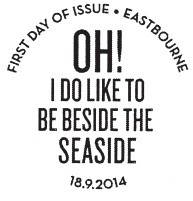
|

|
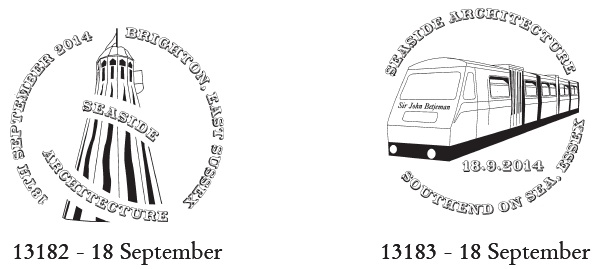
|
Ref FD1418TH
Official Bureau postmark |
Ref FD1418PL
Eastbourne official first day of issue postmark with text 'Oh! I do
like to be beside the seaside' |
Ref L13204 Autumn Stampex first day of
issue
postmark for Seaside Architecture Stamps
|
Ref L13182
Brighton East Sussex |
Ref L13183
Southend on Sea, Essex
|
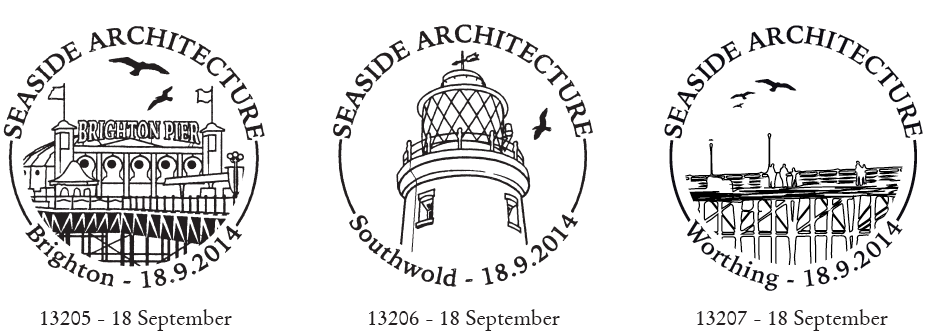
|
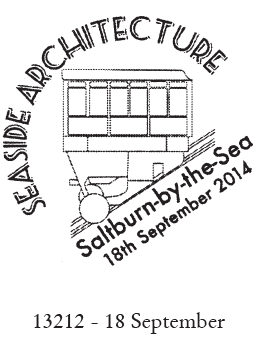
|
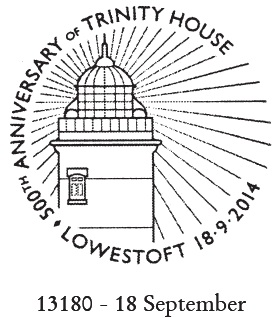
(blank)
|
Ref L13205
Brighton (showing Palace Pier) |
Ref L13206
Southwold (showing lighthouse) |
Ref L13207
Worthing (showing pier)
|
Ref N13212
Saltburn-by-the-Sea
|
Ref L13180 500th
Anniversary of Trinity House, Lowestoft
|
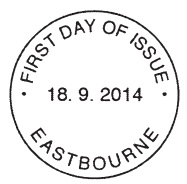
|
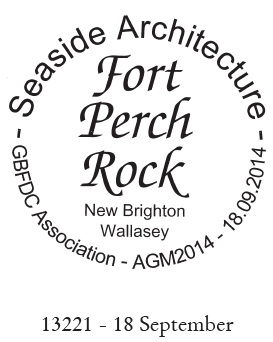
|
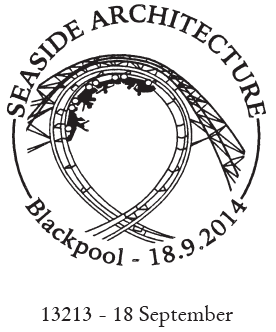
|

|

|
Ref FD1418NP
Eastbourne
|
Ref N13221 Fort Perch
Rock, New Brighton, Wallasey, GBFDC Assoc. |
Ref N13213 Blackpool |
Ref M13187
Birmingham |
*See list of 10 below table * |
*Postmarks in this style will be available
with the following Reference Numbers:
13181 Eastbourne, 13199 Worthing, 13200
Brighton, 13201 Southwold, 13202 Bexhill-on-Sea - all from the London
Handstamp Centre
13214 Blackpool - from the North of England Handstamp Centre;
13216 Dunoon - from the Scotland & NI Handstamp Centre
13220 Plymouth, 13223 Bangor, 13224 Llandudno - all from the Wales &
West Handstamp Centre
If you would like to be
notified when this page changes use the 'ChangeDetection' box above.
This page created 24 August 2014.













